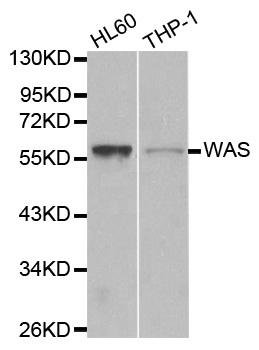WASP (WAS) Rabbit Polyclonal Antibody
USD 436.00
USD 200.00
USD 867.00
Specifications
| Product Data | |
| Applications | WB |
| Recommended Dilution | WB 1:500 - 1:2000 |
| Reactivities | Human |
| Host | Rabbit |
| Isotype | IgG |
| Clonality | Polyclonal |
| Immunogen | Recombinant protein of human WAS |
| Formulation | Store at -20C or -80C. Avoid freeze / thaw cycles. Buffer: PBS with 0.02% sodium azide, 50% glycerol, pH7.3 |
| Concentration | lot specific |
| Purification | Affinity purification |
| Conjugation | Unconjugated |
| Storage | Store at -20°C as received. |
| Stability | Stable for 12 months from date of receipt. |
| Predicted Protein Size | 53 kDa |
| Gene Name | Wiskott-Aldrich syndrome |
| Database Link | |
| Background | Wiskott-Aldrich syndrome proteins (WASPs) mediate actin dynamics by activating the Arp2/3 actin nucleation complex in response to activated Rho family GTPases. In mammals, five WASP family members have been described. Hematopoietic WASP and ubiquitously expressed N-WASP are autoinhibited in unstimulated cells. Upon stimulation they are activated by cdc42, which relieves the autoinhibition in conjunction with phosphatidyl inositol 4,5-bisphosphate. Three WAVE (Wasf, SCAR) family proteins are similar in sequence to WASP and N-WASP but lack the WASP/N-WASP autoinhibition domains and are indirectly activated by Rac . Both WASP and WAVE functions appear to be essential, as knockout of either N-WASP or Scar-2 in mice results in cardiac and neuronal defects and embryonic lethality . Loss of WASP results in immune system defects and fewer immune cells . WAVE-2 (WASF2) is widely distributed, while WAVE-1 and WAVE-3 are strongly expressed in brain . WAVE-3 may act as a tumor suppressor in neuroblastoma, a childhood disease of the sympathetic nervous system . Increased expression of WAVE-3 is seen in breast cancer, and studies in breast adenocarcinoma cells indicate that WAVE-3 regulates breast cancer progression, invasion and metastasis through the p38 mitogen-activated protein kinase (MAPK) pathway . |
| Synonyms | IMD2; SCNX; THC; THC1; WASP; WASPA |
| Reference Data | |
| Protein Families | Druggable Genome |
| Protein Pathways | Adherens junction, Chemokine signaling pathway, Fc gamma R-mediated phagocytosis, Pathogenic Escherichia coli infection, Regulation of actin cytoskeleton |
Documents
| Product Manuals |
| FAQs |
| SDS |
{0} Product Review(s)
Be the first one to submit a review






























































































































































































































































 Germany
Germany
 Japan
Japan
 United Kingdom
United Kingdom
 China
China



